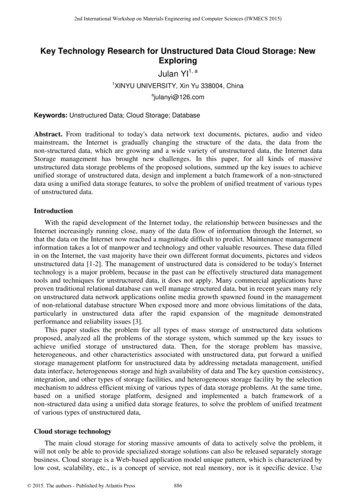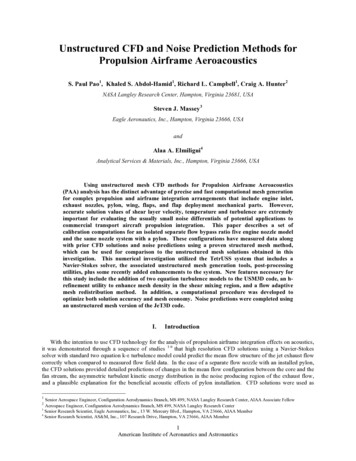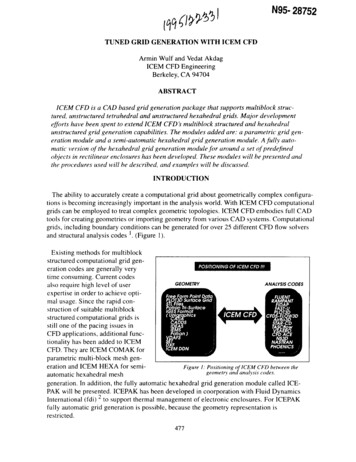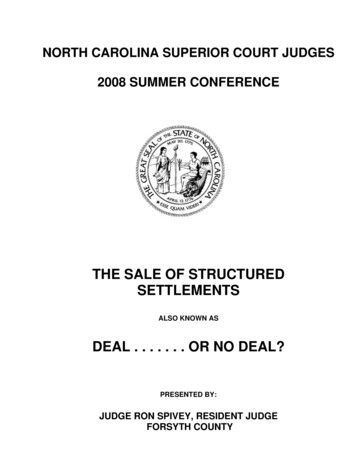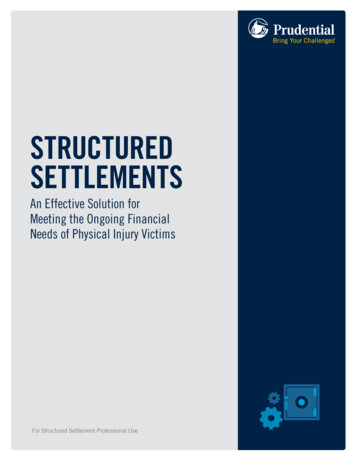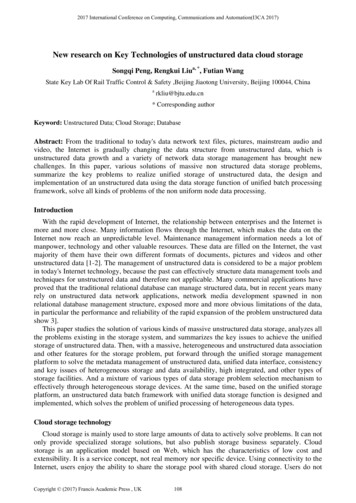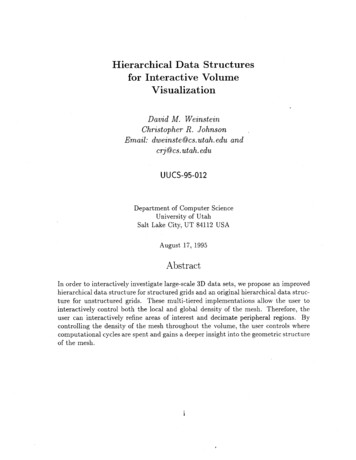
Transcription
LABORATORY OF FLUID DYNAMICS& TECHNICAL FLOWSDEPARTMENT OF FLUID AND HEATENGINEERINGInstitute of Fluid Dynamics &ThermodynamicsFaculty of Mechanical Engineeringand InformaticsOtto von Guericke University MagdeburgUniversity of MiskolcGermanyHungaryCOMPARISON OF STRUCTURED AND UNSTRUCTUREDMESHES FOR THE COMPUTATIONS OF AN H-TYPEDARRIEUS WIND TURBINEFINAL THESISEnergetics engineering MSc,Specialization inEnergy Performance of BuildingsBENCE MOLNÁRNeptun code: XCTPT2Magdeburg2014
Lehrstuhl für Strömungsmechanikund Strömungstechnik (LSS)MSc ThesisStart: 22.09.2014"Comparison of Structured and Unstructured Meshes for the Computations ofan H-Type Darrieus Wind Turbine "Task Literature overview of the wind power and wind turbine technology with focusingon vertical axis wind turbines (H-type Darrieus) Review the scientific literature of CFD computations of H-type Darrieus windturbines with focus on the applied mesh Development of an automatic block structured mesh generation process forrealistic airfoil geometries (for 3 bladed H- Darrieus wind turbines) Evaluation of the performance, torque, lift and drag coefficients for a givengeometry (used in the experiments) with Computational Fluid Dynamics for twodifferent structured mesh resolutions Comparison of the different time dependent coefficients for the two structuredand one unstructured mesh, analysis of the differences Comparison of the convergence speed of the different meshing approaches Draw the conclusions from the comparison and summarizing the advantages anddisadvantages provided by structured and unstructured approaches, applicabilityDer-wuppertaler (C)http://commons.wikimedia.org/wiki/File:BUW Windraeder.JPG?uselangin real world problemsRequired qualifications-Experience with mesh generation, commercial mesh generation software (ICEMCFD) and Computational Fluid Dynamics (ANSYS, Fluent or CD-Adapco STARCCM )-Excellent academic grades in Computational Fluid Dynamics or in equivalent course-Good English knowledgeSupervisorsLászló Daróczy, MSc:laszlo.daroczy@ovgu.de, (0391) 67 18194Gábor Janiga, Priv. Doz.:janiga@ovgu.de, (0391) 67 18196Art of work: Experimental Numeric iiTheoretical/Literature
OTTO VON GUERICKE UNIVERSITYMAGDEBURGInstitute of Fluid Dynamics &ThermodynamicsLaboratory of Fluid Dynamics& Technical FlowsGermanyEnergeticengineering MSc,UNIVERSITY OF MISKOLCFaculty of MechanicalEngineering and InformaticsDepartment of Fluid and HeatEngineering3515 Miskolc – EgyetemvárosHungarySpecialization inEnergy Performanceof BuildingsReference number:EV/400-16/2014MASTER THESISBence MolnárXCTPT2For a second year Master of Science student in Energetic EngineeringField: Energetics, Computational Fluid DynamicsTitle of the thesis: Comparison of Structured and Unstructured Meshes for theComputations of an H-Type Darrieus Wind TurbineTASKS:1. Literature overview of the wind power and wind turbine technology with focusingon vertical axis wind turbines (H-type Darrieus)2. Review the scientific literature of CFD computations of H-type Darrieus windturbines with focus on the applied mesh3. Development of an automatic block structured mesh generation process forrealistic airfoil geometries (for 3 bladed H-Darrieus wind turbines)4. Evaluation of the performance, torque, lift and drag coefficients for a givengeometry (used in the experiments) with Computational Fluid Dynamics for twodifferent structured mesh resolutions5. Comparison of the different time dependent coefficients for the two structuredand one unstructured mesh, analysis of the differences6. Comparison of the convergence speed of the different meshing approaches7. Draw the conclusions from the comparison and summarizing the advantagesand disadvantages provided by structured and unstructured approaches,applicability in real world problemsSupervisor at the University of Miskolc: Péter BencsSupervisors at the OvGU Magdeburg: Dr. Gábor Janiga, László DaróczyStart: 22 September 2014Deadline: 19 December 2014.Prof. Dr. Szilárd SzabóPlace of the sealHead of the Departmentiii
1. Location of final internship: .2. External advisor’s name: .3. The thesis tasks require / do not require modification1:supervisordateIf modification is needed, please list on a separate sheet4. Dates of supervision:datesupervisor5. The thesis is / is not ready for submission.datesupervisoradvisor6. The thesis containspages,and the following documents:drawingssupplementary documentsother supplements (CD, etc.)7. The thesis is / is not ready to be sent to the external reviewer.1The external reviewer’s name:dateHead of Department8. Final evaluation of thesis:External reviewer’s opinion:.Departmental opinion:.Decision of the State Examining Board: .Miskolc, . 1 . .President of the State ExaminingBoardPlease underline appropriate text.iv
Declaration of authenticity/ Eredetiségi nyilatkozatAlulírott Molnár Bence (Neptun kód: XCTPT2), a Miskolci Egyetem Gépészmérnökiés Informatikai Karának végzős Energetikai mérnök szakos hallgatója ezennelbüntetőjogi és fegyelmi felelősségem tudatában nyilatkozom és aláírásommaligazolom, hogy a Comparison of Structured and Unstructured Meshes for theComputations of an H-Type Darrieus Wind Turbine című komplex feladatom/szakdolgozatom/ diplomamunkám2 saját, önálló munkám; az abban hivatkozottszakirodalom felhasználása a forráskezelés szabályi szerint történt.Tudomásul veszem, hogy plágiumnak számit: szószerinti idézet közlése idézőjel és hivatkozás megjelölése nélkül; tartalmi idézet hivatkozás megjelölése nélkül; más publikált gondolatainak saját gondolatként való feltüntetése.Alulírott kijelentem, hogy a plágium fogalmát megismertem, és tudomásul veszem,hogy plágium esetén a szakdolgozat visszavonásra kerül.Miskolc, 202évhónapMegfelelő rész aláhúzandóv
I.SUMMARYNowadays, when renewable energy sources come to the forefront, wind energyrepresents important role because the installation of wind turbine technologyreduces dependence on fossil fuels and provides a cost effective and reliableapproach. Moreover, wind turbines are able to produce large amounts of electricitywithout emitting harmful gases, thus they are environment friendly. In the last fewyears, wind energy generation has increased significantly due to tighteningenvironmental regulations. Although initially the concept of the VAWT (Vertical AxisWind Turbine) (also known as Darrieus turbine) was promising, the large HAWTs(Horizontal Axis Wind Turbines) quickly displaced them. However, VAWTs performbetter in urban regions compared to HAWTs because they do not have to be pointedto the oncoming wind (they are omnidirectional). Hence, there is an increasedinterest in VAWTs, especially the H-type Darrieus concept, because of their simpledesign and their suitability for lower wind speeds. In urban areas the windcontinuously changes direction, thus VAWT is a good option to harness the kineticenergy from the wind. For H-type Darrieus turbines usage to spread, it is essentialto ensure the appropriate efficiency, which is achievable with CFD-based(Computational Fluid Dynamic) optimizations, which require reliable and accuratecomputations. However, in contrast to horizontal axis wind turbines, in the case ofthe H-Darrieus turbines the flow is not only turbulent but also strongly unsteady, withsignificantly varying Angles of Attack (AoA) (and thus aerodynamic characteristics)even during a single rotation. Furthermore, the dominant physical phenomena aredynamic stall and the blade-wake interaction, which make the flow even morecomplicated. The simulation of the dynamic stall and the extremely complex flowstructure is possible only by using a high resolution and fine quality numerical mesh.The Institute of Fluid Dynamics & Thermodynamics at the Otto-von-GuerickeUniversity Magdeburg has a research project which is dealing with the optimizationof H-type Darrieus wind turbine airfoil profile in order to achieve higher performanceand efficiency. The simulations are prepared using the in-house parameterization,design-of-experiment and optimization software of the institute, OPAL . In theearlier studies, an unstructured (partially structured) mesh was used, which is easyto obtain for this construction. However, there was an assumption that usingstructured mesh for the computations may provide significant advantages over theunstructured mesh.vi
Therefore the goal of the current thesis was to create a fine quality block-structuredcomputational mesh for a 2D H-type Darrieus wind turbine for CFD simulations andthen the compare the structured and unstructured meshes in terms of thecomputational results. The structured mesh was expected to improve accuracy ofthe computation and yield fewer residual errors and lower computational time.A high quality 2D structured mesh was generated using the ANSYS ICEM CFDsoftware, where a sliding mesh model was used to simulate the rotation. Moreover,the development of an automatic block structured mesh generation process forrealistic airfoil geometries for three-bladed H-Darrieus wind turbines for theoptimization software was part of the task as well.The numerical simulations were performed on a three-bladed H type Darrieus rotorusing the same solvers and options as in the former studies. The simulations werecarried out for three different TSR (tip-speed ratio) values with two different meshresolution in the commercial CFD software CD Adapco Star CCM .The performance, torque, lift and drag coefficients were evaluated for two differentstructured mesh resolutions. Then the different time dependent coefficients for thetwo structured meshes were compared against the unstructured mesh, and thedifferences were analysed. Then, the convergence speed and the residual errorswere compared for the different mesh approaches.The thesis starts with a literature overview of the wind energy and wind turbinetechnology, detailing VAWTs with the focus on the H-type Darrieus wind turbine.Thereafter the state of the art is described and the scientific literature of CFDcomputations of H-type Darrieus wind turbines with a focus on the applied mesh ispresented. Finally, after presenting the mesh generation process and thecomputational results, conclusions are drawn.vii
II.ÖSSZEFOGLALÁSNapjainkban, amikor a megújuló energiaforrások egyre inkább előtérbekerülnek, a szélenergia fontos szerepet tölt be, ugyanis a szélturbinák telepítésemindamellett, hogy csökkenti a fosszilis üzemanyagoktól való függőséget,költséghatékony, és megbízható megoldást biztosít. Továbbá egy környezetbaráttechnológia, hiszen a szélturbinák képesek nagy mennyiségű elektromos �sanélkül.Aszigorodókörnyezetvédelmi előírások következtében, az elmúlt néhány évben a szélenergiatermelés jelentősen megnövekedett. Habár kezdetben a függőleges tengelyűszélturbinák (mint például Darrieus turbina) biztatóak voltak, a nagyméretűvízszintes tengelyű szélturbinák gyorsan kiszorították őket. Azonban városikörnyezetben, a függőleges tengelyű szélturbinák jobban teljesítenek a vízszintestengelyű szélturbináknál. Ezáltal megnövekedett az érdeklődés a függőlegestengelyű szélturbinák, elsősorban a H-típusú Darrieus koncepció iránt, az egyszerűfelépítésének köszönhetően, valamint, mert jól alkalmazható alacsony szélsebségesetén is. Városi környezetben a szél folyamatosan változatja az irányát, így afüggőleges tengelyű szélturbina egy jó alternatíva a szélben rejlő kinetikus energiakinyerésére. A H-típusú Darrieus szélturbina elterjesztésének érdekében,szükségszerű a megfelelő hatásfok biztosítása, mely elérhető CFD alapúoptimalizálás segítségével, amely megbízható és pontost számítást igényel.Azonban, a vízszintes tengelyű szélturbinákkal ellentétben a H-típusú Darrieusszélturbinák esetében, az áramlás nem csupán turbulens, de erősen instacioner is,jelentősen változó megfúvási szögekkel (és ezáltal áramlási karakterisztikával) máregyetlen körülfordulás alatt is. Továbbá, a domináns fizikai jelenségek, a dinamikaiátesés és a lapát-örvény kölcsönhatás, melyek az áramlást még bonyolultabbáteszik. A dinamikus átesés és a bonyolult áramlási struktúrák numerikusszimulációja, csak nagy felbontású és nagyon jó minőségű numerikus hálóksegítésével lehetséges.A magdeburgi Otto von Guericke Egyetem, Áramlástani és Hőtani Intézete egykutatási projekt keretében, magasabb teljesítmény és hatásfok elérésének céljából,egy H-típusú Darrieus szélturbina lapátprofiljának optimalizálásával foglalkozik. Aszimulációk az intézet saját parametrizáló, kísérlettervezési és optimalizálószoftverével, az OPAL -al készülnek. Az eddigi tanulmányok során strukturálatlan(részben strukturált) hálót alkalmaztak, melyet egyszerű kivitelezni erre aviii
�lthálóhasználataaszámításokhoz, jelentős előnyöket biztosíthat a strukturálatlan hálóhoz képest. Astrukturált háló használatától a számítások pontosságának növekedése, anumerikus hibák csökkenése, alacsonyabb reziduális hibák és rövidebb számításiidő volt az elvárás.Ezért jelen diplomamunka célja egy jó minőségű blokk strukturált számítási DarrieusszélturbináraCFDszimulációkhoz. A számítási háló elkészítéséhez az ANSYS ICEM CFD szoftverkerült alkalmazásra, mellyel jó minőségű 2D blokk strukturált háló lett előállítva.Továbbá, a feladat részét képezte, egy olyan automatikus blokk strukturálthálógeneráló folyamat kidolgozása az optimalizáló szoftverhez, mely képes avalóságban megvalósítható lapátprofil geometriák esetén, egy 2D három-lapátos Htípusú Darrieus szélturbinára, jó minőségű strukturális hálót automatikusangenerálni. Szintén a feladat részét képezte, a numerikus szimulációk eredményeitfelhasználva, a strukturált és strukturálatlan hálók összehasonlítása.A numerikus szimulációk egy három-lapátos H-típusú Darrieus szélturbinán, akorábbi tanulmányokban használt megoldók és beállítások használatával lettekkivitelezve. A szimulációk a CD Adapco Star CCM kereskedelmi CFDszoftverben, 3 különböző gyorsfutási számon lettek elvégezve, két különbözőhálófelbontáson.A teljesítmény, nyomaték, felhajtóerő és ellenállás tényezők kiértékelésre kerülteka két különböző strukturált hálófelbontáson. Ezt követően a két strukturált hálóesetén kapott eredmények összehasonlításra kerültek a strukturálatlan hálóeredményeivel, majd a különbségeket elemzésre kerültek. Végül a számítási idő ésa reziduális hibák kerültek összehasonlításra a különböző hálók esetén.A dolgozat irodalomkutatással kezdődik a szélenergiáról és szélturbinákróláltalánosságban, különös tekintettel a függőleges tengelyű szélturbinákra, ezenbelül is a H-típusú Darrieus szélturbinára fókuszálva. Ezt követően diplomamunkacélja kerül részletezésre, majd a tudományos irodalomból néhány példát kiemelvea H-típusú Darrieus szélturbinák CFD szimulációja során alkalmazott számításihálók kerülnek bemutatásra. Végül, a hálógenerálási folyamat és a számításieredmények bematatását követően, a dolgozat a konklúziók levonásával zárul.ix
TABLE OF CONTENTS1.NOMENCLATURE . 22.INTRODUCTION . 33.4.5.2.1.Wind power. 32.2.Wind turbine technology . 42.3.Vertical axis wind turbines . 102.3.1.Principle of operation . 112.3.2.Savonius wind turbines . 122.3.3.Darrieus wind turbines . 132.4.Problem statement . 162.5.State of the art . 172.6.Literature overview . 192.7.Structure of the thesis . 20COMPUTATIONAL METHODS . 213.1.Governing equations . 233.2.Sliding mesh . 263.3.Reference values, initial conditions and boundary conditions. 26GENERATION OF THE COMPUTATIONAL MESH . 284.1.Block structure . 304.2.Mesh generation. 324.3.Final steps . 364.4.Application of the script to different airfoils . 37COMPUTATIONAL RESULTS . 385.1.Comparison of aerodynamic coefficients . 395.1.1.Torque coefficient for one blade . 395.1.2.Comparison of drag coefficients and lift coefficients . 485.1.3.Comparison of power coefficients . 585.2.Comparison of residual errors and computational times. 586.CONCLUSIONS . 617.ACKNOWLEDGEMENTS . 638.REFERENCES . 641
1. NOMENCLATUREList of symbols:AcCLCDCT T/[ρR2HU 2]CP P/[1/2ρAU 3]DFLFDMnNP 2πNT/60RTtU Wαλ ωR/U ρµσ m][Nm][s][m/s][m/s][ ][-][kg/m3][kg/ms][-][1/s]Projected area of rotorChord lengthLift coefficientDrag coefficientTorque coefficientPower coefficientTurbine diameter (2R)Lift forceDrag forceMach numberRotational speed of rotorNumber of bladesOutput powerTurbine radiusOutput torqueTimeMain wind velocityRelative wind speedAngle of attackTip speed ratioDensityDynamic viscosityTurbine solidityAngular RURANSVAWTAngle of AttackBlade Element MomentumComputational Fluid DynamicsHorizontal Axis Wind TurbineDirect Numerical SimulationLarge Eddy SimulationReynolds- Averaged Navier- StokesSpecific Dissipation RateShear Stress TransportTip Speed RatioUnsteady Reynolds- Averaged Navier- StokesVertical Axis Wind Turbine2
2. INTRODUCTIONIn this chapter and its sub-chapters, I present the basic information about theimportance of wind power and I describe some fundamental details about windturbine technology. Then, I write about the vertical axis wind turbines (VAWTs), asthis particular project is related to this type of wind machines. Thereafter, the aim ofthe work is presented in more detail. In the following, the introduction will bepresented based on the literature review [1-27].2.1. Wind powerNowadays, fossil fuels are the most used widely energy sources. However,according to the opinions of many, they are the major causes of the environmentaldeterioration and global climate change. It is a fact that the power generation fromfossil fuels has many negative environmental effects and because of the tighteningenvironmental regulations the demand for clean energy production is growingcontinuously.Because of the rising world population, the demand for and the consumption ofenergy increased significantly in the twentieth century. Rapid industrial and technicaldevelopment also contributes to the growth of the demand. With this ever increasingenergy claim in the world, it will be more and more important to investigatealternative methods of generating electricity.The price of the energy from the conventional energy sources is increasing with thedemand. Hence, to achieve lower cost in the electricity generation, numerouscountries are searching for low-cost technologies. The expensive and depleting oiland gas compel us to use other available energy sources, such as nuclear energy,solar energy, hydro power, geothermal energy, biofuel sources, and wind energy.The traditional, non-renewable energy sources are limited and they are depletingfast, so the interest in renewable energy sources increases every year. The fact,that the renewables are of abundant supply, is a huge benefit compared to theconventional energy sources. Renewable energy sources help to eliminate thedependence on the oil and gas, which are the most important in these days.In spite of the fact that nuclear power plants are good alternatives to fossil fuels,they have several drawbacks. They require high initial investments and have3
dangerous radiation effects. Furthermore, the radiation can be even moredangerous than during proper operation of a nuclear power plants; some seriousnuclear power plant accidents have occurred already. After the Japanese disasterin Fukushima (2011), the German government decided to close all the nuclearpower plants gradually in the country, thus the generation of sufficient electricalpower has to be solved in another way.Therefore, cheap renewable energy is the future and the solution to every problem,but to provide economical and effective energy production, continuous improvementis essential. The engineering society has the great mission to invent newtechnologies and improve the existing ones. This tendency can be observed all overthe world, not only in Germany and in the European Union.It is clear from above that renewable energy has an important function nowadaysand its importance is increasing continuously. The renewables which are currentlyin use include hydro power, solar energy, biomass, geothermal energy and the windenergy.Beside the other renewable energy sources, in the recent years wind power hasbecome more and more important, because it provides an effective and efficientsolution to reduce the emissions of pollutants and fossil fuel consumption as well.Among the renewables the interest of many is focused on wind power generation,since it is available almost everywhere and requires only a small area for theinstallation (as compared to e.g., solar energy), thus it represents a very importantfunction for many countries nowadays. The dependence on the fossil fuels and theawareness of the limited resources and the increasing pollution are giving a pushforward to wind turbine technology.The wind is always all around us, it is plentiful and free so we have to try to find theway to use it the most effectively.2.2. Wind turbine technologyThis thesis does not give an overall review of wind turbines, just a glimpse intothis huge topic in order to present the basic information needed for this particularwork.4
Wind turbines basically use the kinetic energy of the wind to generate electricity:They harness the kinetic energy contained in the wind and convert it into mechanicalpower, driving an electrical generator which produces electricity. With theappropriate shape of the turbine blades the kinetic energy can be converted toelectrical energy with good efficiency. To achieve the optimal performance, the bestis to install the rotor at an appropriate height (i.e., at the top of a tower), where thewind is blowing continuously [1].Sail boats and windmills are good examples, that the wind has been used as anenergy source since the earliest civilization. Windmills were used for manyapplications such as grind graining or pumping water in antiquity and the MiddleAges [1]. One of the first attempts to generate electricity by using the wind was madein the United States by Charles Brush in 1888 [2]. The first attempts wereencouraging. However, after the initial enthusiasm, the interest and the developmentdecreased due to several reasons, such as low efficiency and performance, largeinvestment costs, limited technical possibilities, the easily usable and cheap fossilfuels and the two World Wars.The interest in wind turbine technology renewed and increased significantly after theoil embargo in 1973 because of the increased cost of electrical energy productionfrom fossil fuels. Several countries invested large amounts of money to improve thetechnique at this time, while today this tendency has renewed because of thedepleting and costly fossil fuels. Hence, many nations plan to make largeinvestments, and the presence of support policies is feeding interest in developingwind turbines. Nowadays, the technology is getting more attention since it ispossible to generate large amount of clean electrical energy with a relatively smallinitial investment. Thus, the number of the installed wind turbines and hereby, thewind power capacity increases every year. The wind turbine technology is capableof satisfying residential, commercial and industrial requirements. Furthermore, it isan attractive electricity source, especially in the parts of the world where theelectrical grid is not available. Since it is modular, it can be built quickly, and it iseasy to fit to the electricity demand and supply. Moreover, as mentioned earlier, thewind turbine technology inflicts no harmful environmental effects, since during theoperation there are essentially no emissions [3].5
Wind turbines have many advantages, so in the following, I summarise the majorbenefits briefly. Perhaps, the most important fact is the pollution free operation, thusit is environmentally friendly after the equipment has been produced. Thetechnology is affordable in the most cases. The operational costs are low and theprice of the generated electricity has decreased significantly in the last decades,thus nowadays it is much cheaper than the electrical energy from fossil fuels andcompetitive with the other renewable energy sources [4]. The wind turbine does notneed 24 hour personnel employment during operation, which reduces the costs, butcareful maintenance is required to avoid breakdowns in case of storms. In the areaswhere an electrical grid is not available, it is almost the only possibility to supplyelectricity. Nowadays, the technology is effective and delivers electricity with highreliability.In spite of its many advantages, it has some drawbacks as well and it would beunfair not to mention a few of them. First of all, the most annoying problem with thewind turbines is that they can be loud, especially in case of high constructions andbig rotor sizes. So in this case, it is important to choose the installation site carefully,far from residential areas, commercial buildings and schools. Moreover, the turbineblades might be dangerous to birds and bats. Furthermore, in case of the largeblades and towers, the visual impression of the wind turbines can be a negativefactor as well. Besides, the initial cost of investment can be quite high depending onmany factors, for example output power rating, tower height and site selection. Incase of any damage to the structure, the repairs might be very expensive.To achieve the optimal efficiency of wind turbines, they require unique installationspecifications. The location of the site, the spacing between two units, the height ofthe towers, and the optimum parameters for rotor blades all have to be chosencarefully. These installation requirements provide safe, reliable and efficientoperation with low maintenance and operation costs.In the case of wind turbines the power coefficient describes how efficiently windpower is utilized and converted into useful turbine power. It can be defined as:𝐶𝑃 𝑃132 𝜌 𝐴 𝑈 (3.1)6
where CP is the power coefficient, P is the power output, ρ is the density of air, A isthe projected area of rotor and U is the main wind velocity. The maximumachievable power coefficient is 59.26 percentage according to the Betz limit namedfor the Albert Betz who published his theory first in 1919 [4].The power coefficient is affected by the tip speed ratio (TSR) of the turbine. The tipspeed ratio is a ratio between the tip blade speed (𝜔 𝑅) and the wind speed. It isdefined as:𝜆 𝜔 𝑅𝑈 (3.2)where ω is the angular speed, R is the rotor radius and U is the main wind speed.Figure 1 shows the power coefficients of the different wind turbine types in thefunction of their tip speed ratio.Figure 1 Power coefficients of wind rotors of different designs [5]In order to make it the discussion about the different type of wind turbines in thefollowing sections easier, a few quantities should be defined first.The torque coefficient is given by the following formula:𝐶𝑇 𝑇122 𝜌 𝑅 𝐴 𝑈 (3.3)7
where T is the output torque, ρ is the density of the air, A is the projected area ofrotor and U is the main wind velocity.Solidity is a measure of airflow blockage with the turbine. It can be defined in severalways, in this thesis the following formula is used:𝜎 𝑁 𝑐𝑅(3.4)where N is the number of the blades and c is the chord le
A high quality 2D structured mesh was generated using the ANSYS ICEM CFD software, where a sliding mesh model was used to simulate the rotation. Moreover, the development of an automatic block structured mesh generation process for realistic airfoil geometries for three-bladed H-Darrieus wind turbines for the
